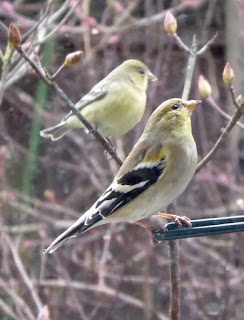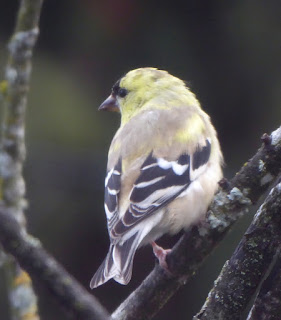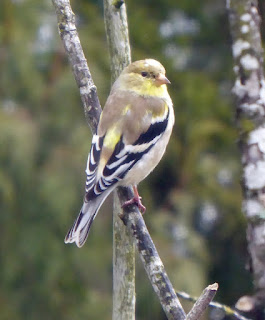 |
| Lesser |
Speaking of things I should know but don’t, and I was just about to, here’s a thing: there is a bird called a Lesser Goldfinch that I never heard of until about five years ago, even though there are a billion of them at any one time in our very yard.
There is nothing like birding to distinguish the people who notice things from the people who are too busy jamming their thumbs up their butts. I have been both of those people in the same day. “Oh, it’s a lesser goldfinch,” I heard someone say on my first Birdathon, and I was duly puzzled. Goldfinches I know. This sounded like a slight. Get to know that goldfinch, I wanted to say, before you start casting nasturtiums.
 |
| Regular |
But in fact a Lesser Goldfinch is considerably smaller than an American Goldfinch, somewhat greenish on the back, a bit less show-offy, has an extra comma on its wing bars, and says “peww, peww. Peww?” I know all that now because apparently, all this time, they have been slathered every which way in my yard. And they’re there all year long. Not noticing them is the very definition of a character flaw.
And so it is I had another smack-my-head observation the other day. I used to notice when the American (“regular”) Goldfinches came back for the season. Hard not to. They’re ridiculously bright yellow. It’s spring, the scent of daphne is in the air, and all of a sudden your tree is filled with sunshine on the wing. It’s like the swallows coming back to Camp Castrato, or wherever, except in your very yard.
 But what I finally noticed is they’ve been back for a while, or never left. They just haven’t been yellow. And now they’re yellowing up. That’s what they do. It’s a work in progress.
But what I finally noticed is they’ve been back for a while, or never left. They just haven’t been yellow. And now they’re yellowing up. That’s what they do. It’s a work in progress.
Birds molt at least once a year. All of them. They have to. They can’t go whackety whackety with those wings all year long and not need to replenish. And many of them have a spring suit and an autumn suit. The males’ nesting season duds are frequently more eye-catching. No particular point in being both eye-catching and tasty in the winter, so then they tend toward dull.
But when they molt, most of them don’t just drop their drawers and haul on a new outfit. It happens feather by feather: the old one gets pushed out, and the new one grows in. And so that nice even beige color of the male winter goldfinch goes spotty and mottly for a while before it’s finally all Hey-Baby yellow.
 Even the dashing goldfinch has dark wings, though. The darker pigment adds strength to the feather, and the tail and wings do the most whacketing, so they need to be able to hold up. You look around. Dollars to donuts your birds are liable to have dark wings and tails too, no matter what other colors they are.
Even the dashing goldfinch has dark wings, though. The darker pigment adds strength to the feather, and the tail and wings do the most whacketing, so they need to be able to hold up. You look around. Dollars to donuts your birds are liable to have dark wings and tails too, no matter what other colors they are.
I feel privileged to have finally been able to notice my birds yellowing up. It’s probably because we moved the bird feeder a foot away from the window. That is a real boon to the near-sighted person. Turns out that you can cut down on bird-window strikes by putting your feeders that close. I’m not sure why, but it seems to have helped. The cat-window strikes from the inside are through the roof, but the birds are doing great.
A couple years ago, we started hanging our suet feeders in the fall and our hummingbird feeders in the spring smack dab in front of our windows. Paul put eye bolts under our eaves, and we hang those long plant/bird feeder hooks from them, onto which I can easily change the food just by opening the window. (We had a squirrel problem with the suet, but Paul attached the cymbals from an old drum set over them as a baffle, and the squirrels were, fortunately, duly baffled.)
It's wonderful to see the hummers and all the woodpeckers close up, and they gradually get used to us gawking at them.
I've got my feeder on a rope-and-pulley sort of deal. So I have to go outside to change it out. The window was installed in 1906 and it's NOT going to move!
I now know that there actually IS a lesser goldfinch. I need to leave the upper Midwest more often. I love watching the birds get all dressed up for mating season. Must be the voyeur in me.
You obviously don't have teenage daughters. Although, watching them getting dressed up for mating season might get you some jail time…..
If I had a teenage daughter who even thought about dressing the way I did, I'd lock her in a closet and slide food under the door until she was thirty.
My older daughter went out looking like Madonna a lot of the time for about three years, then she got married and settled down. My younger daughter barely raised he nose from her book, nothing to worry about there.
We get lots of goldfinches, but now I have to figure out if they are lesser or morrer. We are always a bit put out when they finish turning bright yellow and go north. We see them mainly when they are sort of khaki.
I've never been able to remember if khaki is a color or a fabric.
Oh…I just always assumed it is a color. I could very likely be wrong and I don't want to google it to find out.
Both.
It's a colour. Lots of fabrics can be khaki coloured.
Well, I did google, and yes it's a color, but not the color I thought. It's apparently some kind of yellow-ish brown, and I guess what I thought it was is a faded olive.
Thank god this is not a post about urine, as I first thought when reading the title 🙂 In my defense, there HAS been considerable attention given to poop here lately.
ANYWAY.
I just wanted to say that I made this same realization about the birds yellowing up a couple of years ago and felt quite proud of myself. And the spring is the best time to see them because they are easier to spot before the leaves come out. They are such cheery little specks of brightness.
"casting nasturtiums" – lol!
I think I've only done one post about urine, but it was a pisser.
Gosh… this whole train of thought makes me laugh so hard… I will keep an eye out for yellow birds from now on! I do love the hummers and the woodpeckers a lot. I know what they are!
I too appreciate something I don't mistake for anything else.
I'm not so good at noticing things either, I once didn't notice a new gnome swinging from the carport rafters for a month until hubby pointed it out. But I have noticed the magpie families around here and now know which ones are the teenagers, because their wings aren't pure white like the parents. They still have some grey feathers in there.
…and you also have old gnomes, I assume?
Yes, most bought by me, so I know they're there. It's only the ones he bought and put around the place that I don't notice. The carport one was swinging by the knees like a trapeze gnome and quite small and of course high up and I never looked up there usually.
Welcome to Mumbaihotcollection.com, home of the finest Mumbai escorts in Mumbai area. Our Mumbai escorts are the finest Mumbai has to offer and will provide an unforgettable Mumbai Escort experience!
Escorts in mumbai
Escort service in mumbai
Mumbai escorts
Mumbai call girls
Call girls in mumbai
Escorts mumbai
Mumbai escorts services
Gurgaon escorts
Independents mumbai escorts
Mumbai escorts independents
Mumbai Escorts services
Escort service in mumbai
Escorts in delhi
Escort service in delhi
delhi escorts service